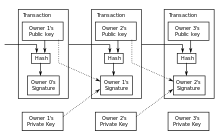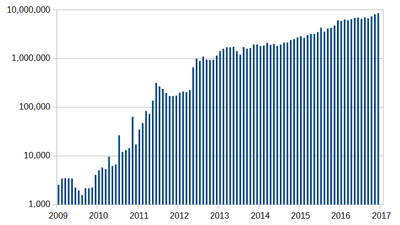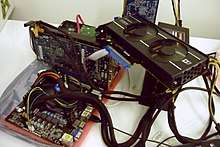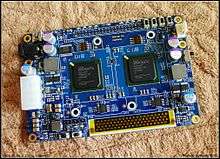Bitcoin network


The bitcoin network is a peer-to-peer payment network that operates on a cryptographic protocol. Users send and receive bitcoins, the units of currency, by broadcasting digitally signed messages to the network using bitcoin cryptocurrency wallet software. Transactions are recorded into a distributed, replicated public database known as the blockchain, with consensus achieved by a proof-of-work system called mining. Satoshi Nakamoto, the designer of bitcoin claimed that design and coding of bitcoin began in 2007. The project was released in 2009 as open source software.
The network requires minimal structure to share transactions. An ad hoc decentralized network of volunteers is sufficient. Messages are broadcast on a best effort basis, and nodes can leave and rejoin the network at will. Upon reconnection, a node downloads and verifies new blocks from other nodes to complete its local copy of the blockchain.[2][3]
Transactions


A bitcoin is defined by a sequence of digitally signed transactions that began with the bitcoin's creation, as a block reward. The owner of a bitcoin transfers it by digitally signing it over to the next owner using a bitcoin transaction, much like endorsing a traditional bank check. A payee can examine each previous transaction to verify the chain of ownership. Unlike traditional check endorsements, bitcoin transactions are irreversible, which eliminates risk of chargeback fraud.
Although it is possible to handle bitcoins individually, it would be unwieldy to require a separate transaction for every bitcoin in a transaction. Transactions are therefore allowed to contain multiple inputs and outputs, allowing bitcoins to be split and combined. Common transactions will have either a single input from a larger previous transaction or multiple inputs combining smaller amounts, and one or two outputs: one for the payment, and one returning the change, if any, to the sender. Any difference between the total input and output amounts of a transaction goes to miners as a transaction fee.[2]
Mining


To form a distributed timestamp server as a peer-to-peer network, bitcoin uses a proof-of-work system.[3] This work is often called bitcoin mining. The signature is discovered rather than provided by knowledge. This process is energy intensive.[4] Electricity can consume more than 90% of operating costs for miners.[5] A data center in China, planned mostly for bitcoin mining, is expected to require up to 135 megawatts of power.[6]
Requiring a proof of work to accept a new block to the blockchain was Satoshi Nakamoto's key innovation. The mining process involves identifying a block that, when hashed twice with SHA-256, yields a number smaller than the given difficulty target. While the average work required increases in inverse proportion to the difficulty target, a hash can always be verified by executing a single round of double SHA-256.
For the bitcoin timestamp network, a valid proof of work is found by incrementing a nonce until a value is found that gives the block's hash the required number of leading zero bits. Once the hashing has produced a valid result, the block cannot be changed without redoing the work. As later blocks are chained after it, the work to change the block would include redoing the work for each subsequent block.
Majority consensus in bitcoin is represented by the longest chain, which required the greatest amount of effort to produce. If a majority of computing power is controlled by honest nodes, the honest chain will grow fastest and outpace any competing chains. To modify a past block, an attacker would have to redo the proof-of-work of that block and all blocks after it and then surpass the work of the honest nodes. The probability of a slower attacker catching up diminishes exponentially as subsequent blocks are added.[3]

To compensate for increasing hardware speed and varying interest in running nodes over time, the difficulty of finding a valid hash is adjusted roughly every two weeks. If blocks are generated too quickly, the difficulty increases and more hashes are required to make a block and to generate new bitcoins.[3]
Difficulty
Bitcoin mining is a competitive endeavor. An "arms race" has been observed through the various hashing technologies that have been used to mine bitcoins: basic CPUs, high-end GPUs common in many gaming computers, FPGAs and ASICs all have been used, each reducing the profitability of the less-specialized technology. Bitcoin-specific ASICs are now the primary method of mining bitcoin and have surpassed GPU speed by as much as 300 fold. As bitcoins have become more difficult to mine, computer hardware manufacturing companies have seen an increase in sales of high-end ASIC products.[7]
Computing power is often bundled together or "pooled" to reduce variance in miner income. Individual mining rigs often have to wait for long periods to confirm a block of transactions and receive payment. In a pool, all participating miners get paid every time a participating server solves a block. This payment depends on the amount of work an individual miner contributed to help find that block.[8]
Bitcoin data centers prefer to keep a low profile, are dispersed around the world and tend to cluster around the availability of cheap electricity.[5]
Energy consumption
In 2013, Mark Gimein estimated electricity consumption to be about 40.9 megawatts (982 megawatt-hours a day).[9] In 2014, Hass McCook estimated 80.7 megawatts (80,666 kW). As of 2015, The Economist estimated that even if all miners used modern facilities, the combined electricity consumption would be 166.7 megawatts (1.46 terawatt-hours per year).[10]
To lower the costs, bitcoin miners have set up in places like Iceland where geothermal energy is cheap and cooling Arctic air is free.[11] Chinese bitcoin miners are known to use hydroelectric power in Tibet to reduce electricity costs.[12]
Process

A rough overview of the process to mine bitcoins is:[3]
- New transactions are broadcast to all nodes.
- Each miner node collects new transactions into a block.
- Each miner node works on finding a proof-of-work code for its block.
- When a node finds a proof-of-work, it broadcasts the block to all nodes.
- Receiving nodes validate the transactions it holds and accept only if all are valid.
- Nodes express their acceptance by moving to work on the next block, incorporating the hash of the accepted block.
Mined bitcoins

By convention, the first transaction in a block is a special transaction that produces new bitcoins owned by the creator of the block. This is the incentive for nodes to support the network.[2] It provides the way to move new bitcoins into circulation. The reward for mining halves every 210,000 blocks. It started at 50 bitcoin, dropped to 25 in late 2012 and to 12.5 bitcoin in 2016. This halving process is programmed to continue for 64 times before new coin creation ceases.
Security
Various potential attacks on the bitcoin network and its use as a payment system, real or theoretical, have been considered. The bitcoin protocol includes several features that protect it against some of those attacks, such as unauthorized spending, double spending, forging bitcoins, and tampering with the blockchain. Other attacks, such as theft of private keys, require due care by users.[13][14][15][16][17][18][19]
Unauthorized spending
Unauthorized spending is mitigated by bitcoin's implementation of public-private key cryptography. For example; when Alice sends a bitcoin to Bob, Bob becomes the new owner of the bitcoin. Eve observing the transaction might want to spend the bitcoin Bob just received, but she cannot sign the transaction without the knowledge of Bob's private key.[14]
Double spending
A specific problem that an internet payment system must solve is double-spending, whereby a user pays the same coin to two or more different recipients. An example of such a problem would be if Eve sent a bitcoin to Alice and later sent the same bitcoin to Bob. The bitcoin network guards against double-spending by recording all bitcoin transfers in a ledger (the blockchain) that is visible to all users, and ensuring for all transferred bitcoins that they haven't been previously spent.[14]:4
Race attack
If Eve offers to pay Alice a bitcoin in exchange for goods and signs a corresponding transaction, it is still possible that she also creates a different transaction at the same time sending the same bitcoin to Bob. By the rules, the network accepts only one of the transactions. This is called a race attack, since there is a race which transaction will be accepted first. Alice can reduce the risk of race attack stipulating that she will not deliver the goods until Eve's payment to Alice appears in the blockchain.[15]
A variant race attack (which has been called a Finney attack by reference to Hal Finney) requires the participation of a miner. Instead of sending both payment requests (to pay Bob and Alice with the same coins) to the network, Eve issues only Alice's payment request to the network, while the accomplice tries to mine a block that includes the payment to Bob instead of Alice. There is a positive probability that the rogue miner will succeed before the network, in which case the payment to Alice will be rejected. As with the plain race attack, Alice can reduce the risk of a Finney attack by waiting for the payment to be included in the blockchain.[16]
History modification
Each block that is added to the blockchain, starting with the block containing a given transaction, is called a confirmation of that transaction. Ideally, merchants and services that receive payment in bitcoin should wait for at least one confirmation to be distributed over the network, before assuming that the payment was done. The more confirmations that the merchant waits for, the more difficult it is for an attacker to successfully reverse the transaction in a blockchain—unless the attacker controls more than half the total network power, in which case it is called a 51% attack.[17]
Deanonymisation of clients
Deanonymisation is a strategy in data mining in which anonymous data is cross-referenced with other sources of data to re-identify the anonymous data source. Along with transaction graph analysis, which may reveal connections between bitcoin addresses (pseudonyms),[13][18] there is a possible attack[19] which links a user's pseudonym to its IP address. If the peer is using Tor, the attack includes a method to separate the peer from the Tor network, forcing them to use their real IP address for any further transactions. The attack makes use of bitcoin mechanisms of relaying peer addresses and anti-DoS protection. The cost of the attack on the full bitcoin network is under €1500 per month.[19]
Payment verification
Each miner can choose which transactions are included in or exempted from a block.[20] A greater number of transactions in a block does not equate to greater computational power required to solve that block.[20]
Upon receiving a new transaction a node must validate it: in particular, verify that none of the transaction's inputs have been previously spent. To carry out that check the node needs to access the blockchain. Any user who does not trust his network neighbors, should keep a full local copy of the blockchain, so that any input can be verified.
As noted in Nakamoto's whitepaper, it is possible to verify bitcoin payments without running a full network node (simplified payment verification, SPV). A user only needs a copy of the block headers of the longest chain, which are available by querying network nodes until it is apparent that the longest chain has been obtained. Then, get the Merkle branch linking the transaction to its block. Linking the transaction to a place in the chain demonstrates that a network node has accepted it, and blocks added after it further establish the confirmation.[2]
Data in the blockchain
While it is possible to store any digital file in the blockchain, the larger the transaction size, the larger any associated fees become. Various items have been embedded, including URLs to child pornography, an ASCII art image of Ben Bernanke, material from the Wikileaks cables, prayers from bitcoin miners, and the original bitcoin whitepaper.[21]
Alleged criminal activity
The use of bitcoin by criminals has attracted the attention of financial regulators, legislative bodies, law enforcement, and the media.[22] The FBI prepared an intelligence assessment,[23] the SEC has issued a pointed warning about investment schemes using virtual currencies,[22] and the U.S. Senate held a hearing on virtual currencies in November 2013.[24] Nobel-prize winning economist Joseph Stiglitz says that bitcoin's anonymity encourages money laundering and other crimes, "If you open up a hole like bitcoin, then all the nefarious activity will go through that hole, and no government can allow that." He's also said that if "you regulate it so you couldn’t engage in money laundering and all these other [crimes], there will be no demand for Bitcoin. By regulating the abuses, you are going to regulate it out of existence. It exists because of the abuses."[25][26]
Several news outlets have asserted that the popularity of bitcoins hinges on the ability to use them to purchase illegal goods.[27][28] In 2014, researchers at the University of Kentucky found "robust evidence that computer programming enthusiasts and illegal activity drive interest in bitcoin, and find limited or no support for political and investment motives."[29]
Black markets
A CMU researcher estimated that in 2012, 4.5% to 9% of all transactions on all exchanges in the world were for drug trades on a single dark web drugs market, Silk Road.[30] Child pornography,[31] murder-for-hire services,[32] and weapons[33] are also allegedly available on black market sites that sell in bitcoin. Due to the anonymous nature and the lack of central control on these markets, it is hard to know whether the services are real or just trying to take the bitcoins.[34]
Several deep web black markets have been shut by authorities. In October 2013 Silk Road was shut down by U.S. law enforcement[35][36][37] leading to a short-term decrease in the value of bitcoin.[38] In 2015, the founder of the site was sentenced to life in prison.[39] Alternative sites were soon available, and in early 2014 the Australian Broadcasting Corporation reported that the closure of Silk Road had little impact on the number of Australians selling drugs online, which had actually increased.[40] In early 2014, Dutch authorities closed Utopia, an online illegal goods market, and seized 900 bitcoins.[41] In late 2014, a joint police operation saw European and American authorities seize bitcoins and close 400 deep web sites including the illicit goods market Silk Road 2.0.[42] Law enforcement activity has resulted in several convictions. In December 2014, Charlie Shrem was sentenced to two years in prison for indirectly helping to send $1 million to the Silk Road drugs site,[43] and in February 2015, its founder, Ross Ulbricht, was convicted on drugs charges and faces a life sentence.[44]
Some black market sites may seek to steal bitcoins from customers. The bitcoin community branded one site, Sheep Marketplace, as a scam when it prevented withdrawals and shut down after an alleged bitcoins theft.[45] In a separate case, escrow accounts with bitcoins belonging to patrons of a different black market were hacked in early 2014.[46]
According to the Internet Watch Foundation, a UK-based charity, bitcoin is used to purchase child pornography, and almost 200 such websites accept it as payment. Bitcoin isn't the sole way to purchase child pornography online, as Troels Oertling, head of the cybercrime unit at Europol, states, "Ukash and paysafecard... have [also] been used to pay for such material." However, the Internet Watch Foundation lists around 30 sites that exclusively accept bitcoins.[31] Some of these sites have shut down, such as a deep web crowdfunding website that aimed to fund the creation of new child porn.[47] Furthermore, hyperlinks to child porn websites have been added to the blockchain as arbitrary data can be included when a transaction is made.[48][49]
Money laundering
Bitcoins may not be ideal for money laundering, because all transactions are public.[50] Authorities, including the European Banking Authority[51] the FBI,[23] and the Financial Action Task Force of the G7[52] have expressed concerns that bitcoin may be used for money laundering. In early 2014, an operator of a U.S. bitcoin exchange, Charlie Shrem, was arrested for money laundering.[53] Subsequently, he was sentenced to two years in prison for "aiding and abetting an unlicensed money transmitting business".[43] Alexander Vinnik, an alleged owner of BTC-e was arrested in Greece July 25 of 2017 on $4 bln money laundering charges for flouting anti-money laundering (AML) laws of the US. A report by UK's Treasury and Home Office named "UK national risk assessment of money laundering and terrorist financing" (2015 October) found that, of the twelve methods examined in the report, bitcoin carries the lowest risk of being used for money laundering, with the most common money laundering method being the banks.[54]
Ponzi scheme
In a Ponzi scheme using bitcoins, the Bitcoin Savings and Trust promised investors up to 7% weekly interest, and raised at least 700,000 bitcoins from 2011 to 2012.[55] In July 2013, the U.S. Securities and Exchange Commission charged the company and its founder in 2013 "with defrauding investors in a Ponzi scheme involving bitcoin".[55] In September 2014 the judge fined Bitcoin Savings & Trust and its owner $40 million.[56]
See also
References
- ↑ "Charts". Blockchain.info. Archived from the original on 3 November 2014. Retrieved 2 November 2014.
- 1 2 3 4 Nakamoto, Satoshi (24 May 2009). "Bitcoin: A Peer-to-Peer Electronic Cash System" (PDF). Retrieved 20 December 2012.
- 1 2 3 4 5 Barber, Simon; Boyen, Xavier; Shi, Elaine & Uzun, Ersin (2012). "Bitter to Better – how to make Bitcoin a better currency" (PDF). Financial Cryptography and Data Security. Springer Publishing.
- ↑ Peter Kelly-Detwiler (21 July 2016). "Mining Bitcoins Is A Surprisingly Energy-Intensive Endeavor". Forbes. Retrieved 7 January 2017.
- 1 2 Lester Coleman (25 July 2016). "As Mining Expands, Will Electricity Consumption Constrain Bitcoin?". cryptocoin news. Retrieved 7 January 2017.
- ↑ "Mining Bitcoin With Wind And Solar Power". Energy Matters. 7 November 2016. Retrieved 7 January 2017.
- ↑ "Bitcoin boom benefiting TSMC: report". Taipei Times. 4 January 2014.
- ↑ Biggs, John (8 April 2013). "How To Mine Bitcoins". Techcrunch.
- ↑ Gimein, Mark (13 April 2013). "Virtual Bitcoin Mining Is a Real-World Environmental Disaster". Bloomberg Business. Bloomberg LP. Retrieved 22 April 2015.
- ↑ "The magic of mining". The Economist. 13 January 2015. Retrieved 13 January 2015.
- ↑ O'Brien, Matt (13 June 2015). "The scam called Bitcoin". Daily Herald. Retrieved 20 September 2016.
- ↑ Maras, Elliot (14 September 2016). "China's Mining Dominance: Good Or Bad For Bitcoin?". Cryptocoin News. Retrieved 25 November 2016.
- 1 2 Ron Dorit; Adi Shamir (2012). "Quantitative Analysis of the Full Bitcoin Transaction Graph" (PDF). Cryptology ePrint Archive. Retrieved 18 October 2012.
- 1 2 3 Jerry Brito & Andrea Castillo (2013). "Bitcoin: A Primer for Policymakers" (PDF). Mercatus Center. George Mason University. Retrieved 22 October 2013.
- 1 2 Erik Bonadonna (29 March 2013). "Bitcoin and the Double-spending Problem". Cornell University. Retrieved 22 October 2014.
- 1 2 Karame, Ghassan O.; Androulaki, Elli; Capkun, Srdjan (2012). "Two Bitcoins at the Price of One? Double-Spending Attacks on Fast Payments in Bitcoin" (PDF). International Association for Cryptologic Research. Retrieved 22 October 2014.
- 1 2 Michael J. Casey; Paul Vigna (16 June 2014). "Short-Term Fixes To Avert "51% Attack"". Money Beat. Wall Street Journal. Retrieved 30 June 2014.
- 1 2 Reid, Fergal; Harrigan, Martin (2013). "An Analysis of Anonymity in the Bitcoin System". Security and Privacy in Social Networks: 197–223.
- 1 2 3 Biryukov, Alex; Khovratovich, Dmitry; Pustogarov, Ivan (2014). "Deanonymisation of clients in Bitcoin P2P network". ACM Conference on Computer and Communications Security.
- 1 2 Houy, N. (2016). "The Bitcoin Mining Game". Ledger. 1 (0): 53–68. doi:10.5195/ledger.2016.13. Retrieved 14 January 2017.
- ↑ "How porn links and Ben Bernanke snuck into Bitcoin's code". CNN Money. CNN. 2 May 2013.
- 1 2 Lavin, Tim (8 August 2013). "The SEC Shows Why Bitcoin Is Doomed". bloomberg.com. Bloomberg LP. Retrieved 20 October 2013.
- 1 2 "Bitcoins Virtual Currency: Unique Features Present Challenges for Deterring Illicit Activity" (PDF). Cyber Intelligence Section and Criminal Intelligence Section. FBI. 24 April 2012. Retrieved 2 November 2014.
- ↑ Lee, Timothy B. (21 November 2013). "Here's how Bitcoin charmed Washington". The Washington Post. Retrieved 10 October 2016.
- ↑ Montag, Ali (9 July 2018). "Nobel-winning economist: Authorities will bring down 'hammer' on bitcoin". CNBC. Archived from the original on 11 July 2018. Retrieved 11 July 2018.
- ↑ Newlands, Chris (9 July 2018). "Stiglitz, Roubini and Rogoff lead joint attack on bitcoin". Financial News. Archived from the original on 11 July 2018. Retrieved 11 July 2018.
- ↑ "Monetarists Anonymous". The Economist. The Economist Newspaper Limited. 29 September 2012. Retrieved 21 October 2013.
- ↑ Ball, James (22 March 2013). "Silk Road: the online drug marketplace that officials seem powerless to stop". theguardian.com. Guardian News and Media Limited. Retrieved 20 October 2013.
- ↑ Matthew Graham Wilson & Aaron Yelowitz (November 2014). "Characteristics of Bitcoin Users: An Analysis of Google Search Data". Social Science Research Network. Working Papers Series. SSRN 2518603.
- ↑ Christin, Nicolas (2013). Traveling the Silk Road: A Measurement Analysis of a Large Anonymous Online Marketplace (PDF). Carnegie Mellon INI/CyLab. p. 8. Retrieved 22 October 2013.
we suggest to compare the estimated total volume of Silk Road transactions with the estimated total volume of transactions at all Bitcoin exchanges (including Mt.Gox, but not limited to it). The latter corresponds to the amount of money entering and leaving the Bitcoin network, and statistics for it are readily available... approximately 1,335,580 BTC were exchanged on Silk Road... approximately 29,553,384 BTC were traded in Bitcoin exchanges over the same period... The only conclusion we can draw from this comparison is that Silk Road-related trades could plausibly correspond to 4.5% to 9% of all exchange trades
- 1 2 Schweizer, Kristen (10 October 2014). "Bitcoin Payments by Pedophiles Frustrate Child Porn Fight". BloombergBusiness. Bloomberg LP. Retrieved 16 February 2015.
- ↑ Lake, Eli (17 October 2013). "Hitman Network Says It Accepts Bitcoins to Murder for Hire". The Daily Beast. The Daily Beast Company LLC. Retrieved 17 February 2015.
- ↑ Smith, Gerry (15 April 2013). "How Bitcoin Sales Of Guns Could Undermine New Rules". huffingtonpost.com. TheHuffingtonPost.com, Inc. Retrieved 20 October 2013.
- ↑ Alex, Knapp (19 January 2015), "Faking Murders And Stealing Bitcoin: Why The Silk Road Is The Strangest Crime Story Of The Decade", Forbes, retrieved 2 January 2016
- ↑ Andy Greenberg (23 October 2013). "FBI Says It's Seized $28.5 Million In Bitcoins From Ross Ulbricht, Alleged Owner Of Silk Road" (blog). Forbes.com. Retrieved 24 November 2013.
- ↑ Kelion, Leo (12 February 2014). "Five arrested in Utopia dark net marketplace crackdown". bbc.co.uk. BBC. Retrieved 13 February 2014.
- ↑ Alex Hern (3 October 2013). "Bitcoin price plummets after Silk Road closure". The Guardian. Retrieved 31 October 2014.
Digital currency loses quarter of value after arrest of Ross Ulbricht, who is accused of running online drugs marketplace
- ↑ Robert McMillan (2 October 2013). "Bitcoin Values Plummet $500M, Then Recover, After Silk Road Bust". Wired. Retrieved 31 October 2014.
- ↑ "Silk Road drug website founder Ross Ulbricht jailed". BBC News. BBC. 29 May 2015. Retrieved 30 May 2015.
- ↑ Katie Silver (31 March 2014). "Silk Road closure fails to dampen illegal drug sales online, experts say". ABC News. Retrieved 31 October 2014.
- ↑ Sophie Murray-Morris (13 February 2014). "Utopia no more: Drug marketplace seen as the next Silk Road shut down by Dutch police". The Independent. London: independent.co.uk. Retrieved 8 November 2014.
- ↑ Wakefield, Jane (7 November 2014). "Huge raid to shut down 400-plus dark net sites". bbc.com. BBC. Retrieved 8 November 2014.
- 1 2 Nate Raymond (19 December 2014). "Bitcoin backer gets two years prison for illicit transfers". Reuters. Thompson Reuters. Retrieved 20 December 2014.
- ↑ "Ross Ulbricht: Silk Road creator convicted on drugs charges". BBC. 5 February 2015. Retrieved 17 February 2015.
- ↑ Ravi Mandalia (1 December 2013). "Silk Road-like Sheep Marketplace scams users; over 39k Bitcoins worth $40 million stolen". Techie News. Retrieved 2 December 2013.
- ↑ "Silk Road 2 loses $2.7m in bitcoins in alleged hack". BBC News. 14 February 2014. Retrieved 15 February 2014.
- ↑ "While Markets Get Seized: Pedophiles Launch a Crowdfunding Site". Retrieved 19 February 2015.
- ↑ Hopkins, Curt (7 May 2013). "If you own Bitcoin, you also own links to child porn". The Daily Dot. Retrieved 16 February 2015.
- ↑ Bradbury, Danny. "As Bitcoin slides, the Blockchain grows". IET Engineering and Technology Magazine.
- ↑ Kirk, Jeremy (28 August 2013). "Bitcoin offers privacy-as long as you don't cash out or spend it". PC World. Retrieved 31 October 2014.
- ↑ "Warning to consumers on virtual currencies" (PDF). European Banking Authority. 12 December 2013. Archived from the original (PDF) on 28 December 2013. Retrieved 23 December 2013.
- ↑ "Guidance for a Risk-Based Approach: Prepaid Cards, Mobile Payments and Internet-based Payment Services" (PDF). Guidance for a risk-based approach. Paris: Financial Action Task Force (FATF). June 2013. p. 47. Retrieved 6 March 2014.
- ↑ Lee, Dave (27 January 2014). "US makes Bitcoin exchange arrests after Silk Road closure". bbc.co.uk. BBC. Retrieved 28 January 2014.
- ↑ "UK national risk assessment of money laundering and terrorist financing" (PDF). UK HM Treasury and Home Office. Retrieved 3 May 2016.
- 1 2 "SEC charges Texas man with running Bitcoin-denominated Ponzi scheme" (Press release). US Securities and Exchange Commission. 23 July 2013. Retrieved 7 March 2014.
- ↑ Jay Adkisson (25 September 2014). "Bitcoin Savings & Trust Comes Up $40 Million Short On The Trust Part". Forbes. Retrieved 13 December 2014.